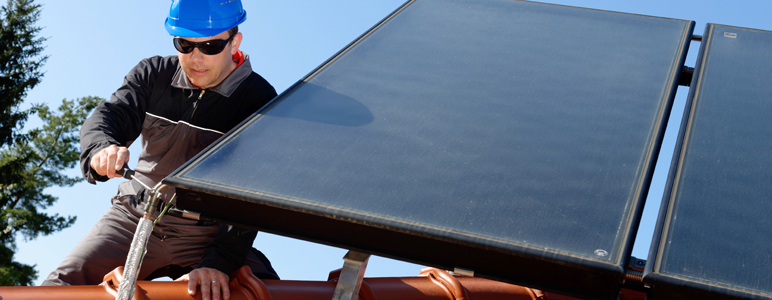


The greening of California’s electric grid gets a lot of attention – we’re committed to 50 percent renewable energy by 2030, with some state legislators pushing to increase that commitment to 100 percent by 2045. This bold leadership on reducing fossil fuel use and climate action planning from the world’s sixth largest economy is encouraging.
However, electricity is only one piece of the puzzle. According to the California Air Resources Board, natural gas consumption in residences and commercial buildings accounts for nearly 10 percent of California’s total greenhouse gas (GHG) emissions. The lion’s share of this natural gas use is for space and water heating. If we want to achieve our ambitious GHG reduction goals, we need to find a better way to heat our water and indoor areas.
Recognizing this, Governor Jerry Brown signed AB-797 (Irwin) into law on October 4, extending the California Solar Initiative Thermal Program for an additional two years, through the end of 2019. The program provides rebates for qualifying solar water heating systems for single-family and multifamily homes, commercial and industrial properties and commercial swimming pools.
An oldie, but goodie
Solar water heating is not new. The first patent for a solar water heating system in the U.S. was filed in 1890, and in 1979, President Jimmy Carter put solar water heating on the White House. It’s a tried and true technology, which uses heat from the sun to warm water, rather than create electricity. Over the past four decades, its adoption has shifted with the rising and falling of natural gas prices, but for homeowners and business owners who installed solar water heating, their utility costs savings have continued.
The state’s solar thermal market is growing, especially in the multifamily housing sector, according to the California Solar Energy Industries Association. Almost every business uses hot water, whether it’s for hand sinks and showers or high-volume commercial dishwashers, heavy-duty laundries or industrial processes, and solar water heating helps achieve profitable and sustainable operations.
Rebates make the difference
With natural gas so cheap today, the economics of installing a solar water heating system often don’t pencil out – that’s where the rebates come in.
Combined with the federal investment tax credit of 30 percent for systems in service by the end of 2019, CSI Thermal rebates can reduce the out-of-pocket expenses for a single-family homeowner to under $2,000. A residential system, which will typically last for 25 years, can pay for itself through reduced natural gas bills after around 10 years. For larger multifamily and commercial systems, customers who make use of the federal tax credit and CSI rebates of up to $800,000 per installation, are recovering their costs in as short as six years.
By encouraging market activity, these rebates also promote competition among manufacturers and installers, driving both innovation and cost reductions.
Higher rebates for low income
AB-797 also calls for a 50 percent carve-out of the program’s total budget for low-income and disadvantaged communities, in addition to higher rebate levels. This helps ensure these communities, many of which have disproportionately borne the brunt of air and water pollution, are able to benefit from clean energy resources and lower utility bills for water heating.
Learn how you can save
CSE administers the CSI Thermal Program for the California Public Utilities Commission in the San Diego Gas & Electric service area. Visit our CSI-Thermal website to learn more about solar water heating and available rebates.

